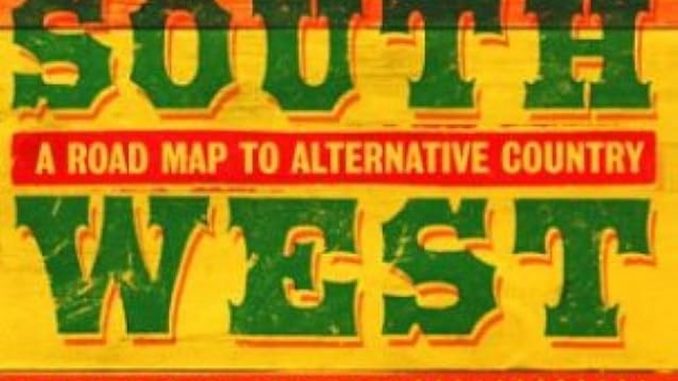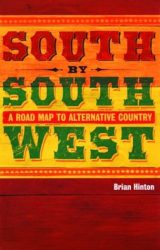
 ‘South By Southwest’ is a book that often gets suggested as a source text for those wanting to learn more about Americana. It had passed me by until recently, so with the danger of lobbing another grenade into the “what is Americana” debate in mind I dived in.
‘South By Southwest’ is a book that often gets suggested as a source text for those wanting to learn more about Americana. It had passed me by until recently, so with the danger of lobbing another grenade into the “what is Americana” debate in mind I dived in.
Brian Hinton has biographies of a variety of musical subjects to his name, including Joni Mitchell, Elvis Costello, and Van Morrison. He has also attempted to cover some wider musical topics. ‘Country Roads: How Country Came To Nashville’ looks at the journey of country from Celtic and Appalachian folk through to discussions of everyone from Hank Williams to Bob Dylan, by way of Elvis Presley.
Which brings us to the book in question here. In the introduction, he looks at the festival that his book shares its name with and suggests Austin as the starting point for a journey around Americana. He actually comes up with some halfway-decent definitions of Americana. Starting with: “It is the opposite of contemporary Nashville and its heartless gloss. Real music for real people.” Musically his definition includes Ornette Coleman’s ‘Skies of America’, Leon Payne’s ‘Americana: Rare Ballads And Tall Tales’ and Michael Chapman’s ‘Americana’ album. The latter is fair enough but I’m not sure we’ll be featuring Avant Garde Jazz in the pages of AUK anytime soon. The Payne album is an interesting candidate for the first Americana album, but that’s not a rabbit hole we’ll disappear down today.
But then he comes up with this. “[Americana] is something deep and folksy and slightly creepy, about family and nostalgia and blood and sex and religious faith and death. By itself that would be well-nigh unbearable, but there is a matching and extremely deadpan sense of humour, born of fatalism and the funnier for that”. Reading further into the book he produces other tropes that mark out Americana as a music style. The recurring theme of a steam train winding across the prairie, and from a British perspective he takes Jackie Leven’s ‘Heroin Dealer Blues’ as another archetype. A London heroin dealer dreams of escaping to the prairie and a better life, before being shot dead.
After this promising start the book drifts off into a history of the genre that starts with Cecil Sharp, Harry Smith, The Carter Family, and The Kingston Trio. The main aspect of interest here is that it pulls together the roots (also the title of the chapter) of the various strands of Americana and joins the dots that connect the pioneers of folk and country to Dylan, The Grateful Dead and The Nitty Gritty Dirt Band.
The section of the book called “Branches” becomes increasingly muddled. Starting with an attempt to break Americana down into subgenres, something he seems to give up on halfway through in favour of categories based on regions of the USA. The web of relationships between bands like Wilco, Soul Asylum, The Jayhawks, Run Westy Run, and Big Star that coalesced around the “supergroup” Golden Smog would make a great basis for exploring the development of Americana and/or Alt.Country. Hinton, however, seems to have trouble sorting who played what with who, and when. So, the opportunity to dig into the influences that have shaped 21st century Americana promptly vanishes. Tom Waits seems to be the only current inhabitant of a sub-genre called Avant Garde Americana, so I may yet be wrong about Ornette Coleman.
The subtitle “A Roadmap To Alternative Country” led me to believe that we were taking a ride through the general territory with some stopping off points signed along the way. Indeed, I wouldn’t have found Geoff Muldaur’s ‘The Secret Handshake’ without it, but I suspect this is a book for the cautiously interested to dip into Americana and learn some of the names. Reader reviews of the book online suggest that names like Uncle Tupelo, and Lucinda Williams came as a surprise.
Brian Hinton’s primary career is as a poet, literary magazine editor, and researcher into the Tennyson circle’s time on the Isle of Wight in the late 19th and early 20th century, especially the portrait photographer Julia Margaret Cameron. This is an area of research that lends itself to easier pigeonholing of people, the places they lived in and the art that they created, than maybe music created in bars and studios with no clear linear progression is.
South By Southwest ultimately collapses under the weight of its scholarly intentions. Examining a narrower slice of the Americana pie may have produced a more coherent book. It may even have produced several books. Interestingly tucked away at the back of my 2003 edition is a recommendation for a then shiny and new Americana UK.
The first Americana album?
You can see where Hinton was going with suggesting this as Americana, kind of…
The archetypal Americana song?


